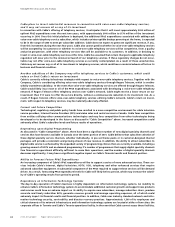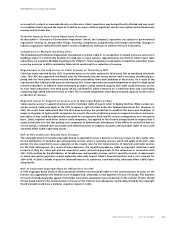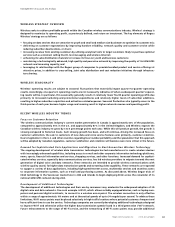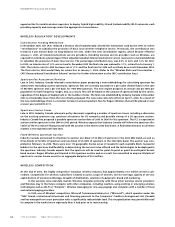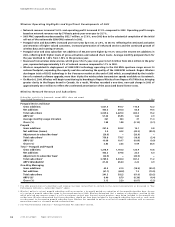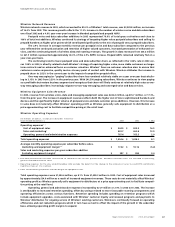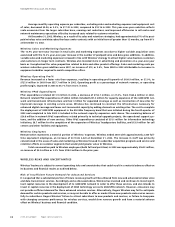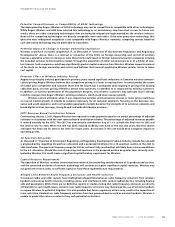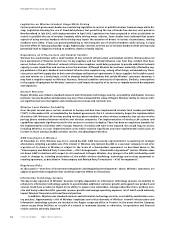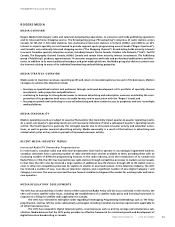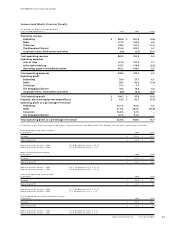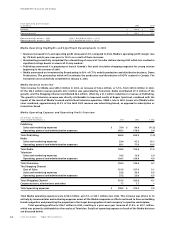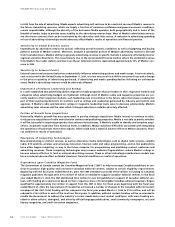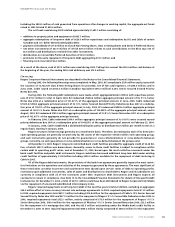Rogers 2003 Annual Report Download - page 51
Download and view the complete annual report
Please find page 51 of the 2003 Rogers annual report below. You can navigate through the pages in the report by either clicking on the pages listed below, or by using the keyword search tool below to find specific information within the annual report.
2003 Annual ReportRogers Communications Inc. 49
Potential Competitiveness or Compatibility of EDGE technology
The deployment by Rogers Wireless of EDGE technology may not be competitive or compatible with other technologies.
While Rogers Wireless and AWE have selected this technology as an evolutionary step from their current to future net-
works, there are other competing technologies that are being developed and implemented by the wireless industry.
None of the competing technologies are directly compatible with each other. If the next generation technology that
gains the most widespread acceptance is not compatible with Rogers Wireless’ networks, competing services based on
such alternative technology may be preferable to subscribers.
Potential Impact of Change in Foreign Ownership Legislation
Wireless could face increased competition if, as discussed in “Overview of Government Regulation and Regulatory
Developments” above, there is a removal or relaxation of the limits on foreign ownership and control of wireless
licences. Legislative action to remove or relax these limits could result in foreign telecommunication companies entering
the Canadian wireless communications market, through the acquisition of either wireless licences or of a holder of wire-
less licences. Such companies could have significantly greater capital resources than Wireless. Wireless supports removal
of the limits on foreign ownership and control and believes that removal would give Wireless greater access to lower
cost capital.
Potential Effect of Wireless Industry Pricing
Aggressive pricing by industry participants in previous years caused significant reductions in Canadian wireless communi-
cations pricing. Rogers Wireless believes that competitive pricing is a factor in causing churn. It cannot predict the extent
of further price competition and customer churn into the future, but it anticipates some ongoing re-pricing of its existing
subscriber base, as lower pricing offered to attract new customers is extended to or requested by existing customers.
In addition, as wireless penetration of the population deepens, new wireless customers may generate lower average
monthly revenues than Rogers Wireless’ existing customers, which could slow revenue growth.
Wireless cannot anticipate what, if any, impact new wireless communications services or lower prices could have
on overall market growth. It intends to compete vigorously for all customer segments, focusing on the business, con-
sumer and youth segments, and in all Canadian geographic markets based on the strengths of its extensive networks and
broad digital services coverage, strong brands and wide distribution presence.
CRTC Revenue-Based Contribution Scheme
Commencing January 1, 2001, Rogers Wireless was required to make payments equal to an annual percentage of adjusted
revenues in accordance with the new revenue-based contribution scheme. The percentage of adjusted revenues payable
is revised annually by the CRTC. The CRTC has announced a contribution levy of 1.1% as both the final rate for 2003 and
the interim rate for 2004. While the rate has been reduced modestly over each of the last two years, Wireless cannot
anticipate the final rate for 2004 or the rates for future years. An increase in the rate would have a negative impact on
operating profits.
3G Spectrum Allocation
As discussed in “Overview of Government Regulation and Regulatory Developments” above, Industry Canada has released
a proposed policy regarding 3G spectrum allocation and a proposed timeframe for a 3G spectrum auction in the 2005 to
2006 timeframe. The spectrum frequency range for 3G has not been fully resolved but will likely bear a close resemblance
to the U.S. allocation. Should the cost of acquiring such spectrum in the proposed auction be greater than currently antic-
ipated by Wireless, this could create a significant capital funding requirement for Wireless.
Capital Resource Requirement
The operation of Wireless’ wireless communications network, the marketing and distribution of its products and services,
and the continued evolution of network technology will continue to require significant capital resources. Wireless may
not generate or have access to sufficient capital to fund these expected future requirements.
Alleged Links Between Radio Frequency Emissions and Health Concerns
Occasional media and other reports have highlighted alleged links between radio frequency emissions from wireless
handsets and various health concerns, including cancer, and interference with various medical devices, including hearing
aids and pacemakers. While there are no definitive reports or studies stating that radio frequency emissions are directly
attributable to such health issues, concerns over radio frequency emissions may discourage the use of wireless handsets
or expose Wireless to potential litigation. It is also possible that future regulatory actions may result in the imposition of
more restrictive standards on radio frequency emissions from low powered devices such as wireless handsets. Wireless is
unable to predict the nature or extent of any such potential restrictions.
Management’s Discussion and Analysis



